
|   |

|   |
The tale of Nal-Damayanti in Chhau and Odissi - Shveta Arora e-mail: shwetananoop@gmail.com Pics: Anoop Arora May 26, 2016 The lawns of Kamani auditorium were verdant and manicured, and in the foyer, the flower rangoli was elaborate and fragrant, with stands holding diyas. The venue was as pleasing as the dance when ‘Nal Damayanti’ was premiered in Delhi by Ranjana Gauhar, who has also learnt Kathak, Manipuri and Chhau. 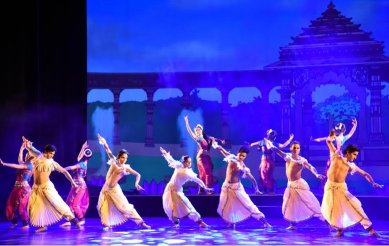
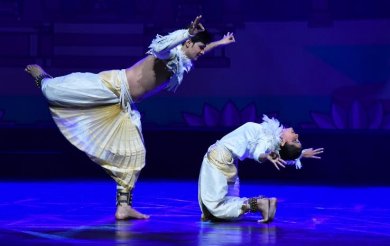
About the story and choreography, Ranjana said, “This love story is not very popular in North India. It is a story from the Mahabharata, told to Yudhishthira by a sage. Our rishis have always spun beautiful and unusual stories, and this one is about love. The Odissi had to be complimented with Chhau since some things come out better in Chhau, like the dice game. The swans have movements which go better with Chhau. It is the only classical form of dance in India which carries a lot of animal movements.” The production had a significant audio-visual element, with many scenes using the AV for the background or even the primary setting and characters. When asked what led to the idea of an AV, Ranjana explained, “When I was toying with the idea of using this story, I discussed it with my son, who specializes in filmmaking and animation. He gave me the idea of using audio-visual, and I immediately agreed because I strongly feel that classical dancers should break their tight boundaries. It has to continuously evolve. We cannot keep on doing the same things; we have to mould ourselves to be relevant. It does not take away from tradition. Even the young people I have worked with have ensured that the contemporary gels with the traditional. The costumes and choreography are traditional. Internationally, animation is being used, but in India, we are still wary of using it. The conservative will argue that the dance forms are equipped to depict anything. But we have to try and connect to the youth too.” The story of Nal-Damayanti begins with a sage narrating the story to Yudhishthira. It was done as an audio-visual presentation. King Nal, essayed by Rakesh Saibabu, was introduced as an honest and kind king. The palace lawns were shown using multimedia, with fountains that could have been possible only with technology. The lonely king is strolling in the lawns when a group of swans comes by. The swans were depicted by dancers in Chhau with slow and graceful yet energetic movements. The costumes for the swans, with their white feathers, were pretty. Nal makes friends with a male swan, the two dance together and Nal asks him to stay back. What is being shown here is an interaction between man and bird. But the swan chooses to stay with its mate, to whom it is committed for life. Nevertheless, he promises to find the king an appropriate mate. Multimedia is used to depict the swan flying for days through rough weather to reach Vidarbha to meet the princess Damayanti. The background had facades of palaces where princess Damayanti is dancing with her friends. Ranjana’s disciple Vrinda essayed the role of Damayanti in Odissi. Vrinda looked beautiful and her command on her style was good. Here, the swan persuades her to choose Nal as her husband. Though many kings and gods try to sabotage the swayamvar, Nal and Damayanti are nevertheless married. The following frame was very romantic, with a night sky and dancing stars, where Nal and Damayanti do a duet to depict their courtship. 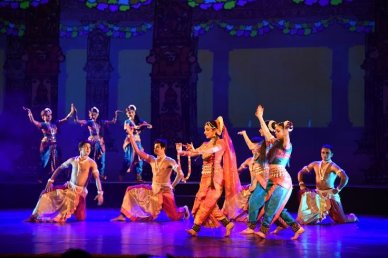
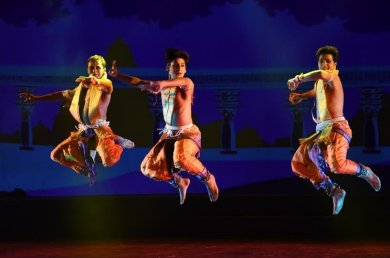
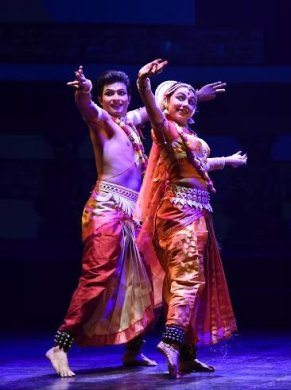
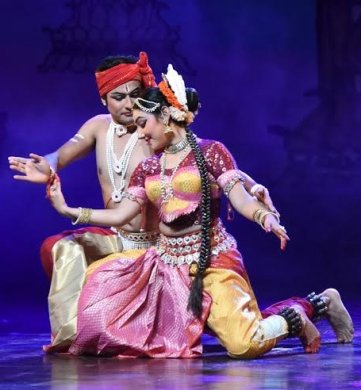
Nal is riled by dark dreams, with his disturbed thoughts depicted by the dancers. He is invited to a game of dice by his brother Pushkar, and loses all to him. The dice game was depicted in Chhau by the male dancers. The couple start to live in exile in the forests. Eventually, a heartbroken Nal leaves his wife and goes away, since he cannot provide for her. While he is leaving, he sees a serpent in flames and throws water on him to douse the fire – all of this was shown in animation. The serpent, in return, gives him a boon that allows him to take any form he wishes. On the other side, Damayanti is attacked by a python and then by a demon. The animated creatures looked way bigger than the dancers, who were lost in the frame. Separated, Nal and Damayanti start working in the palaces of other kings in disguise. Finally, Damayanti’s father finds her and arranges for another swayamwar to save his daughter, who is withering away in grief. The swan acts as a messenger again, conveying to Nal what is happening, and the two lovers are united. The final scene has a beautiful dance by the couple. Any kind of innovation is always appreciable, particularly combining tradition and technology. It also becomes more appealing for the younger audience. The concept, creative direction and Odissi choreography were by Ranjana Gauhar. Script, multimedia visualization and direction were by Siddharth Daniels, her son. Music composition was by Bankim Sethi, Chhau choreography by Rakesh Saibabu, and voiceover by Avarey Chaurey, Purnendu Bhattacharya and Shoumik Ray. The compere was Sadhna Shrivastav. The technical director was the ever brilliant Sandeep Dutta. The dancers were Sunil Mehra, Zaheed Perwej, Aditya Shrivasta, Ankit Pahadiya, Ravija Varma, Kevin Bachhan (Chhau), and Vrinda Chaddha, Zofia Lichota, Pragya Ghosh, Ankita Bakshi, Ishani Nag, Nitika Saran, Niharika Prakash and Sanya Chaddha (Odissi). Shveta Arora is a blogger based in Delhi. She writes about cultural events in the capital. |